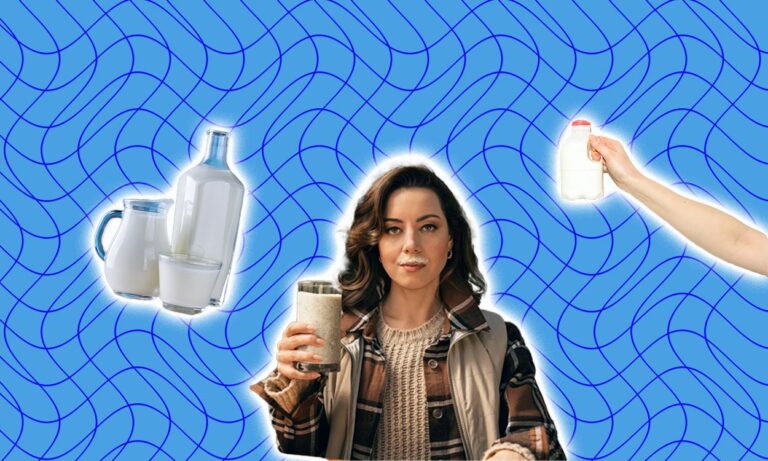Is gen Z bringing dairy back or moo-ving on from milk for good?

Am I a millennial or am I gen Z? It’s a question I wrap my head around often as a person trying to navigate through my mid-20s. And while my birth year lands me on the fence between two eras—zillennial, meaning I’m old enough to remember dial-up, but young enough to doomscroll on TikTok—the key to pinning down my generation may have been in my fridge all along. Milk… Hear me out.
Milk is facing somewhat of an identity crisis, with the drink going out of style faster than skinny jeans. According to recent consumer market research by Circana, in 2022 gen Z bought 20 per cent less milk than the national average. In Europe, the UK-based dairy cooperative Arla published data that found 49 per cent of gen Zers felt ashamed to order dairy in public in front of their peers.
“Although the data showed that 70 per cent of gen Z would prefer to continue to drink dairy, an alarming 57 per cent plan to give it up in the next year,” the supporting press release by Arla read. “Almost a third (29 per cent) even admitted to only ordering dairy alternatives when in public, reverting to their favoured choice of dairy when in the comfort and privacy of their own homes.”
And while there’s some truth in the premise that this has led to a generational ‘milk war’, milk has actually been on the decline for quite some time now. Milk, in the US at least, had its glory days back in the 1940s—peaking at annual consumption of 45 gallons per person in 1945, according to the US Department of Agriculture. That stat fell to around 23 gallons in 2001 and just to 16 gallons in 2021.
So is gen Z really moo-ving on from milk for good? And if so, what are those with stakes in the dairy industry doing to buck this trend and bring back the dairy days? Well, buckle up because there’s a lot to unpack.
Marketing to get milk back on the mind
Before we begin, it wouldn’t be right to explore this topic without mentioning one of the most iconic ad campaigns of all time: Got milk? In the mid-90s, an era void of social media, where the internet was only in its infancy, the “Got milk?” slogan managed to make dairy milk sexy.
The campaign’s concept was simple yet highly effective. It featured print advertisements and TV commercials showcasing various scenarios where people found themselves in desperate need of milk but didn’t have any. These ads often depicted models and famous icons with milk moustaches, emphasising the question, “Got milk?”
And it worked—for a short while at least, milk was cool. A ‘micro bump’ in milk drinking was found across the US, as described in a corroborated 1999 study showing that milk checkoff ads caused a 6 per cent hike in milk sales. Although the hype was short-lasting, with milk’s popularity continuing to fall in the years following, the very fact Got milk? is still a recognisable slogan almost three decades on is impressive, to say the least.
Enter the 2020s: with the rise of dairy alternatives, the dairy milk industry has quite possibly its biggest hill to climb yet. In a desperate bid to ‘make milk great again’, marketers are firing on all cylinders, all gas, no breaks.
“We have to reclaim milk’s mojo,” Yin Woon Rani, the chief executive of MilkPEP, a marketing firm representing the dairy industry that has made substantial investments in the millions to bring milk back, told the New York Times. “We sometimes refer to milk as the OG sports drink, powering athletes for 10,000 years.”
Yes, you read that right. Milk marketing has focused its efforts on packaging its product as a sports beverage. In a strategic move, milk processors are investing in the empowerment of women and girls by running initiatives, as well as supporting equity in sports as a whole.
And while the health benefits of milk in sports are conflicting, there is evidence to show that chocolate milk contains electrolytes and a ratio of carbohydrates to protein that helps boost post-workout recovery. Milk marketing has also targeted a slew of sports communities, from Olympic medalists to Women’s American Football, and even rock climbing.
And then there are influencers jumping on the milk bandwagon too: from Emma Roberts promoting dairy milk on her Instagram, which subsequently received backlash online, to Aubrey Plaza’s viral Wood Milk ad, which poked fun at dairy alternatives and was accused of violating US federal law.
On the other side of the coin, milk marketing is targeting gamers too—declaring it the official “performance beverage” at last year’s TwitchCon gaming convention. I’ll stick to Mountain Dew, thanks. Even Minecraft isn’t safe from milk marketing, with the Dairy Management Inc hiring Preston Arsement and MrBeast to introduce seven new cows to the game, all while promoting sustainable dairy-farming practices.
Can milk make its comeback?
So, has the marketing worked? Well, it’s a mixed bag. It’s safe to say the MilkPEP’s efforts haven’t lived up to the magnitude of the OG Got milk? campaign. But while much of the data available suggests that milk is still in decline amongst gen Zers, some argue that its revival is brewing—at least in New York City coffee shops.
“Hot girls are ditching the alternatives and are going back to basics,” writes Emily Sundberg in an article for Grub Street, drawing on her experience of New Yorkers choosing dairy milk over alternatives. “The real international delight, I realised, is pouring whole, full-dairy milk into your coffee; it is perhaps the most civilised activity in which a person can partake.”
Whichever side of the milk debate you find yourself on, it’s important to point out the damage milk drinks have on the planet. Dairy is particularly destructive for the planet, but almond milk, as well as a slew of other alternatives, are bad too. For our environment’s sake, if you really must have milk, choose oat. Or better yet, go for the nuclear option, and don’t have milk at all.





